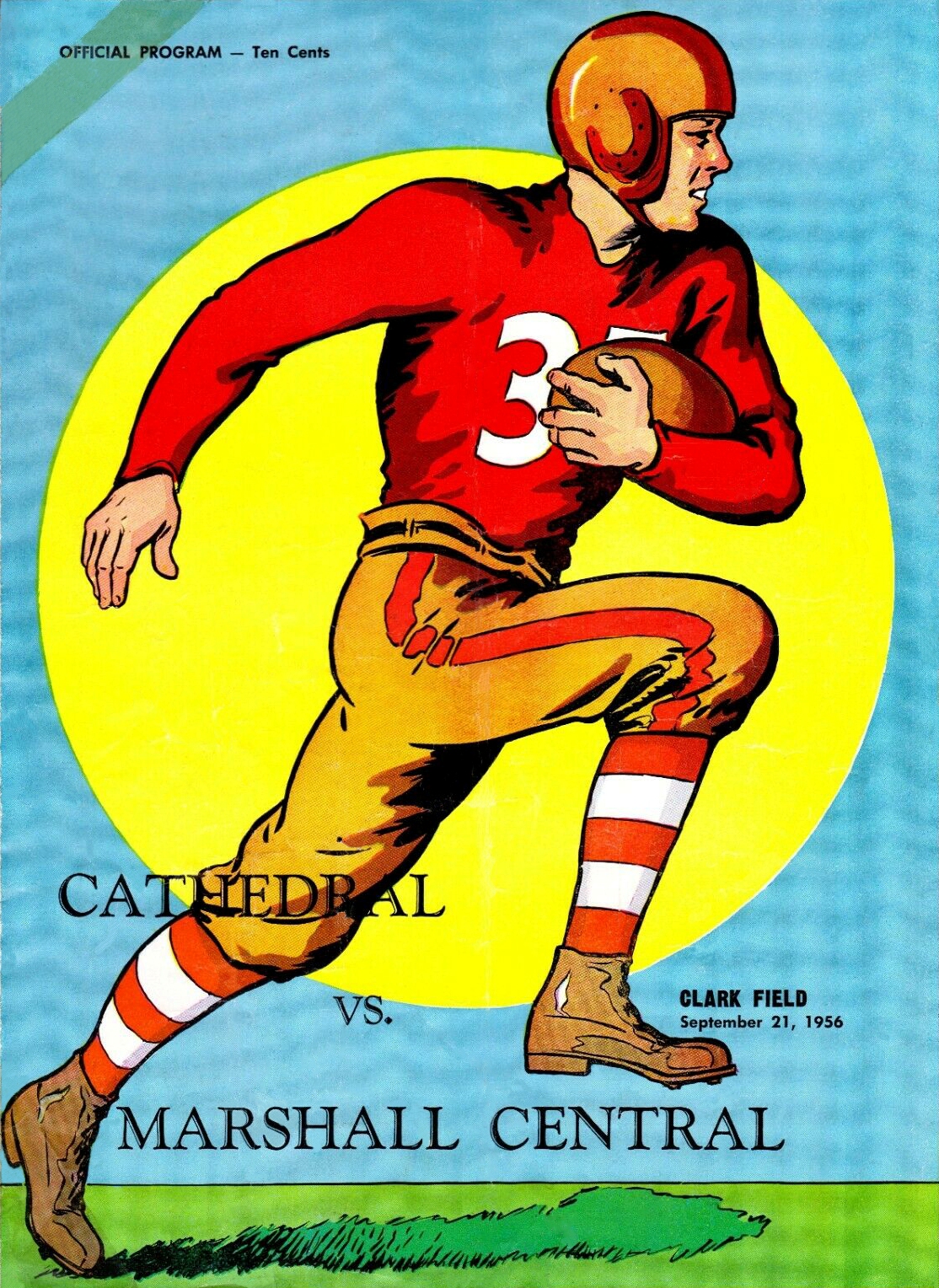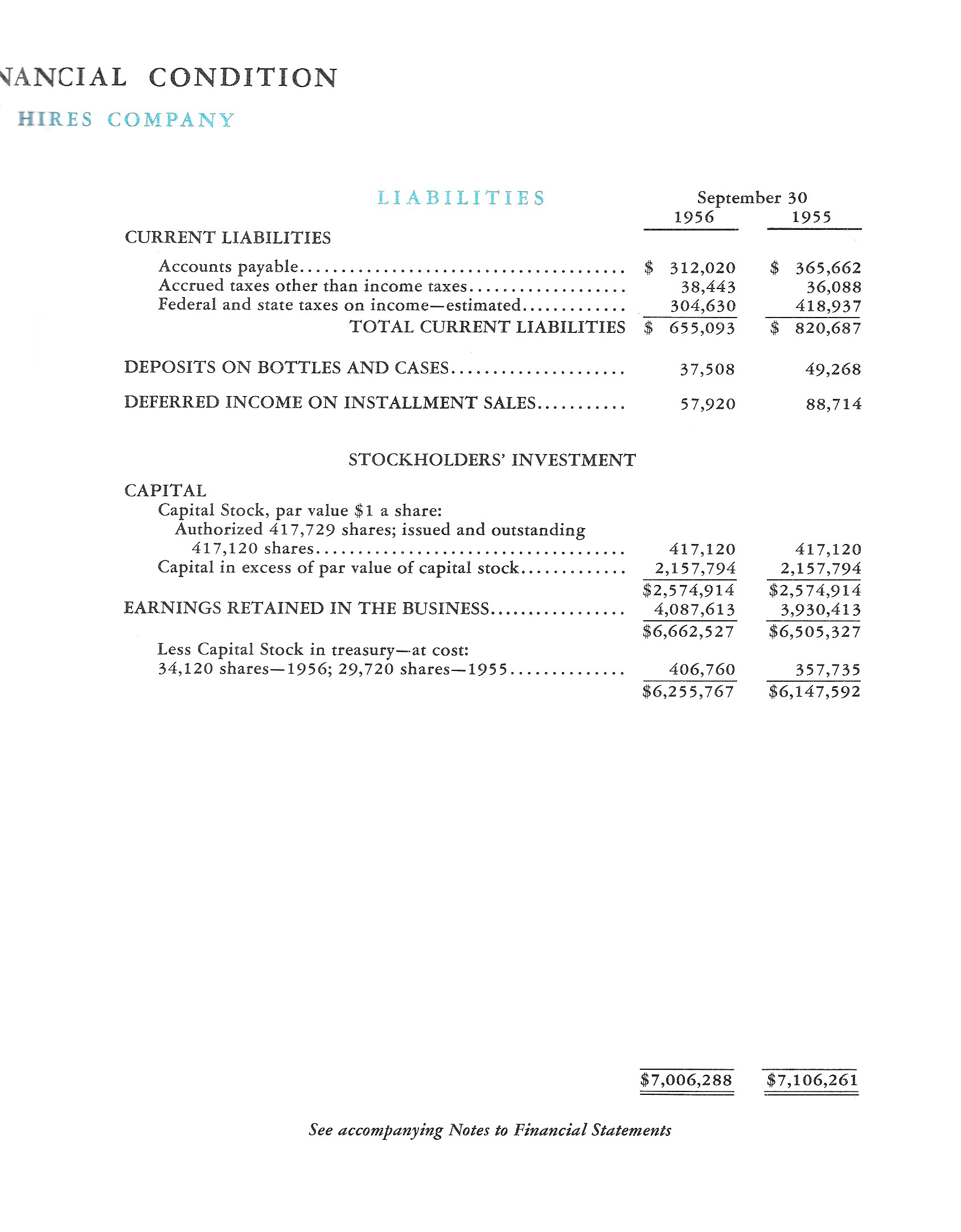1956
IT HAPPENED IN…1956
U.S. farm production set a record in spite of
widespread drought and crop restrictions.
The Agriculture Act included a “soil bank” plan to reduce
surpluses.
The U.S. Federal Highway Act authorized a 42,500
mile network linking all major urban centers.
90% of the $25 billion cost was to be funded by the federal
government, with completion estimated by 1968.
The system wasn’t completed until 1993.
Southern states defied the Supreme Court ruling
against public school segregation and blacks boycotted the
Montgomery, Alabama bus system.
Social Security benefits were expanded to include
disability insurance.
United and TWA airliners crashed into the Grand
Canyon during a thunderstorm killing 128 people in the worst U.S.
commercial air disaster to date.
Dwight D. Eisenhower was re-elected President of
the United States in a landslide.
The U.S. motto “In God We Trust” was authorized.
Youthful rebellion was fueled by political,
social, and technological changes, evidence the meteoric rise of
Elvis Presley whose three appearances on Ed Sullivan’s
Toast of the Town
television show were watched by 82.6% of the total television
audience.
Johnny Cash recorded “Folsom Prison Blues” and “I
Walk The Line” at Sun Studios in Memphis.
The first “Dear
Abby” newspaper column was published in the
San Francisco Chronicle.
The “Huntley-Brinkley Report” with Chet Huntley
and David Brinkley premiered as NBC’s evening television newscast.
Don Larsen of the New York Yankees pitched the
only perfect game in World Series history.
Newly introduced products and inventions included
Scotchgard, television remote controls, Play-Doh, and Yahtzee games.
Forty brands of soft drinks were being canned,
with overseas shipments by Coca-Cola, Pepsi-Cola, Canada Dry, Nehi,
and Hires.
5,218 U.S. soft drink bottling plants were in
operation. Per capita
consumption was 188.9 bottles.
Hires to You!, Volume 10, Number 1, the February, 1956 issue, pictured two female bowlers, both of whom were enjoying Hires Root Beer from vending machine cups.
(Figure
1956-01, Hires
to You! Volume 10, Number 1, February, 1956, front
cover)
The inside front cover presents a
cost-per-fountain-drink comparison between Hires and an “other brand” at
a charge of 5¢ per drink. A
footnote suggests “If you charge 10¢ per drink your Gross Profit per
Gallon increases accordingly.”
Interestingly, there were no added comments about potential
customer dissatisfaction with a 100% increase in the cost of a drink, a
concern that certainly wasn’t ignored by dealers.
(Figure
1956-01, Hires
to You! Volume 10, Number 1, February, 1956, inside
front cover)
This issue’s lead article touted Hires Finished
Fountain Syrup’s 1955 sales success.
(Figure
1956-01, Hires
to You! Volume 10, Number 1, February, 1956, page
3)
(Figure
1956-01, Hires
to You! Volume 10, Number 1, February, 1956, page
4)
This Hires To You! Volume 10,
Number 1, February, 1956 article explained a “new philosophy…revealed to
the entire Hires bottler organization at regional meetings…during
January and February:”
Tremendous Sales Potential: THE TEEN-AGE MARKET
By George F. Finnie, Director of Advertising & Merchandising
In any approach to advertising
and merchandising, the market to be reached must be carefully defined.
But when an 80-year old firm with a reputation built on product
acceptance by the adult population, reverses itself, and clearly defines
the Teen-age Market as its sole objective – that
real news.
This new philosophy – together with a revitalized,
progressive attitude toward advertising and merchandising – was revealed
to the entire Hires bottler organization at regional meetings held in
various parts of the country during January and February.
A pleasantly surprised and highly enthusiastic
bottler organization learned some of the more important factors which
helped to influence us to pin-point our advertising and merchandising to
the teen-age group in 1956.
280 Gallons of "Pop"
The tremendous potential of the youth market was graphically revealed to the bottlers by an illustration showing the estimated quantities of certain food products consumed by the typical teen-ager from birth to the age of 17. Included in this list were such items as 3,500 hot dogs, 4,000 quarts of milk, 3,500 ice cream cones, 2,000 pounds of meat, 4,000 bowls of cereal, 5,000 bars of candy, (and) 4,500 bottles of soda pop.
Faced with potential figures such as this, is it any
wonder than Hires sales and advertising executives (and those of other
food manufacturers) are sitting up nights learning jive talk?
Everyone who sells to the Teen-age Market has his own
statistics on its scope and potential.
For example, someone has estimated that 60% of all soft drinks
made are consumed by persons between the ages of 10 and 22.
Whether or not this estimate is correct is of minor importance.
We do know beyond a doubt that youth consumption represents the
bulk of the soft drink sales.
Reliable sources estimate there are probably 25,000,000 boys and
girls in the United States between the ages of 12 to 22.
Every year some 3,000,000 are added, while a similar number
graduate into the adult consumer group.
The means over 11,000 new prospects for Hires come into the youth
market every day.
Bigger Birth Rate Began It
These figures are undoubtedly bigger than they have ever been. With population trends as they are, the youth market will certainly continue to get bigger for a number of years. This shifting market is not difficult to understand when we take certain facts into consideration. The bulk of the 25% growth in population in this country comes through the tremendous jump in the birth rate since World War II. The bumper crop of war babies is now old enough to play an important part in the consumer market. With births ever rising, a steady growth in the youth market is assured for years to come.
On this premise, and to be certain this approach
could be justified, the company decided to embark on a market research
project of the teen-ager and “young twenty” groups.
The company subsequently hired the Eugene Gilbert Company, a
market research organization specializing in youth research.
More than $8,000 was spent for an exclusive and intensified study
of the youth market in major American cities.
The Eugene Gilbert youth research organization
performs the same functions as any reputable research organization, with
one important distinction.
The company is designed to find answers
only among the young people
who comprise the youth market.
The roots of this distinction lie in the use of young people as
field interviewers.
For the purpose of the Hires survey the Gilbert
Company used high school and college students highly recommended by the
faculty advisors and marketing instructors.
Questionnaires were carefully prepared to include such subjects
as brand preferences, motivation, tastes, place of consumption and
frequency. The survey took
over eight weeks to complete and resulted in volumes of data.
The results of the survey confirmed beyond a doubt the decision
of Hires to concentrate its advertising and merchandising efforts in the
youth market.
The results of the survey emphasized once again the
need for returning to basic essentials: distribution, sampling,
prominent display and consumer advertising.
The importance of adequate distribution was clearly brought out
by the findings of the survey.
For example, there is no question when a young person does not
find his favorite brand of soft drink in the store, he will usually
accept a substitute. Nine
out of 10 young people will drink something different, according to the
results of the survey. Less
than one out of 20 will go to another store.
This means that nearly every time a young person is thirst, if he
wants a Hires – and it is not available – a sale may be lost forever.
One-third Uninitiated
Interviewers reported that
three out of 10 of the soft-drink-consuming youth market in Hires
territories have not yet tasted Hires.
With a potential this high the need for additional sampling is
obvious.
In trying to evaluate
advertising effectiveness it was found our slogan “HIRES TO YOU” fared
very well in comparison to other national brand slogans.
An analysis of Hires advertising penetration as compared to other
competitive soft drinks brought out some interesting facts.
Radio and magazines apparently dominate the mediums where
advertising has been most effective for Hires.
The complete survey of Teen-age Market provided us
with sufficient data to see how effective our present advertising has
been, what percentage of the market we have saturated, where the
greatest opportunities for growth originate, what the consuming person
looks like, what media young people remember seeing our advertising in,
as well as many other important items for future marketing strategy.
The previous
Hires To You! article mentioned “bottler organization…regional
meetings,” and this follow-up article explained the purpose and content
of those sessions:
Into our SECOND YEAR of SUCCESS
By Edward Stern, General Sales Manager, Franchise Division
Our second annual series of Regional Sales Meetings
was an all-‘round success.
The ten meetings held in as many cities across the country were heavily
attended by enthusiastic groups of Hires bottlers.
These regional get-togethers are one more example of
the Company’s strong conviction that “all business is
local.”
The grass-roots reaction is wanted and needed by the Home Office.
That is why we tried this give-and-take type of meeting last year
as an experiment. It worked
so well the first time and it worked even better the second time…
Everybody Likes Previews
The moviemakers know the value of previews.
So does the Hires organization.
An enthusiastic reception greeted the new advertising and
merchandising program and its colorful pieces wherever we unveiled them.
A considerable number of items was shown – point-of-purchase
pieces, sales promotion and merchandising aids of all types, even the
new color designs and national magazine advertisements.
Orders were taken on the spot for promotional
materials, with a promise of early delivery to the bottlers.
Subject matter ran the gamut from sales, advertising,
and merchandising budgets and their operation through marketing
procedures, production techniques, product control, all the way to route
engineering.
As before, meetings were highlighted by periods of
spirited discussion. These
unusually provocative sessions contributed much in suggestions,
recommendations, exchange of ideas, airing of problems, and in
clarification of many controversial questions.
Home Office personnel took back many sound ideas for development
to meet changing conditions in bottlers’ territories.
New Revelations
A particularly lively discussion followed the
informative presentation on the Premix at every meeting.
This system of mixing carbonation and syrup in advance of the
filling operation has tremendous advantages of speed and uniformity.
The whole story was re-told at the meetings, with good reception.
The bottlers were also advised that additional
personnel were being added to give more attention to work to be done in
bottler territory. This
move answers a long-standing need for closer co-operation between the
Company and bottler sales organization in developing markets and putting
on promotions…
New Goals, New Efforts
Targets for many new bottlers for the year were set
up. A large increase in the
1956 advertising budget was announced.
As a result of better and more effective advertising being
planned, goals calling for a 28% increase in case sales were announced.
A definite objective was established – The Teen-age Market.
All advertising has been designed to point to this target.
Greater continuity and integration will typify the new
promotional efforts.
The response was deeply gratifying.
The effects of the second Regional Sales Meeting will continue to
be felt throughout the coming year – a year that looks like the most
promising yet for Hires and our bottlers.
This informative
Hires to You! article was
penned by Robert W. Murphey, a member of the Client Service Staff at N.
W. Ayer & Son:
HIRES and its ADVERTISING AGENCY
People in other lines of
business often ask us, at N. W. Ayer & Son, “Just what does an
advertising agency do?”
An easy answer to this question is, “The agency
prepares and places advertising for its clients.”
However, in practice, it isn’t that simple – nor, as some
believe, that glamorous.
The preparation of advertising is the end result rather than the
beginning.
Formula for Success
First, an agency must have clients with strong and
good management character, willing and able to promote and expand
distribution of good products.
Next, the agency must develop, with its client’s
cooperation, a specific objective – a plan of action.
The best brains of the Ayer agency and the combined resources of
its principal departments are brought to bear on the preparation of an
advertising plan designed for each client.
The services of many specialists – market analysts, copywriters,
art directors, and experts in media – are needed, but their
contributions must be welded and blended into a harmonious flow of ideas
and results. To a large
extent The Plan is evolved
rather than created and ultimately becomes, in most cases, a compromise
between the views of the client and those of the agency.
Business Contemporaries
In Hires, Ayer finds a client with fine management character, an excellent product, a long record of accomplishment and ambition to grow continually….Hires and Ayer have been building business character, strength and influence for approximately the same number of years – since 1876 – from headquarters in the same city, Philadelphia. Hires is the oldest soft drink manufacturer with a record of continuous national advertising. Ayer is the oldest (and one of the largest) advertising agencies. Both pioneered ideas, developed good management character and have grown strong and respected as a result.
Hires is a “growth company,” as are all other Ayer
clients. We can’t work with
any other kind because any company content to hold its own ignores its
problems and therefore cannot solve them.
More importantly, growth companies help spark ideas which kindle
new approaches to all sales and distribution problems.
Helping One Helps All
Helping clients solve such problems is Ayer’s
business. This approach to
agency service started in 1899 when Ayer took on the advertising program
of the newly formed National Biscuit Company.
In those days crackers were sold in bulk, out of open barrels on
the grocer’s floor. We
designed an air-tight package, a distinctive brand name and a trademark
as well as a coordinated plan for reaching the public through every
available advertising channel.
This successful campaign pioneered in the packaging and selling
field of staples. Ideas,
techniques and experiences gained in that campaign were useful in
helping other clients of the time just as the combined experiences of
individual clients of today help all other Ayer clients.
Every year members of Ayer’s large staff make
thousands of calls on the trade in every section where their clients
sell. They call on
distributors and retailers, ride with route-salesmen, (and) question
consumers. In no other way
can we get the feel of the market, dig up facts and mistaken notions
alike. With this primary
experience, we can accurately prepare and interpret larger sample
surveys.
Two Ayer clients provide us with working laboratories
in fields vitally important to Hires.
These are Penn Fruit Company (a chain of supermarkets which does
the largest volume of business per store in the business – more than $3
million per unit), and Peoples Drug Stores (a local chain which is
nationally recognized as the sales leader in the field).
Networks of cooperation such as this benefit all Ayer clients.
This is the organization behind the preparation of
advertising which produces profitable results.
From this we get The Plan
for individual clients like Hires.
Now we are in a safe position to prepare the advertising and
schedule it in newspapers, magazines, radio, television and other media.
The Plan guides the
copywriters, artists, radio-TV producers, and other specialists in
interpreting the ideas.
The Plan keeps things moving
toward a common target – sales.
Hires and Ayer have cooperated for a large portion of
their business lives. We
believe that Hires will not only maintain its present top leadership in
the Root Beer field but that Hires Root Beer is coming into its greatest
period of growth.
If anyone should ask, “Where is Hires headed?” the
answer is, “Forward!”
The happy customers pictured in this advertisement
include seven young people and a Dalmation!
(Figure
1956-02, Look,
April 3, 1956)
Once again, the emphasis was on target marketing to
active, younger customers.
(Figure 1956-03,
Saturday Evening Post)
Hires repeated as a winner of Motion Picture Herald magazine's ”Theatre Sales Champion” award in 1956.
(Figure
1956-04, Motion
Picture Herald magazine)
Here’s yet another reminder to bottlers that Hires was targeting younger
customers. Also note the
announced change to “Clean, refreshing blue stripes (that) give a
youthful feeling to Hires’ complete new line of catchy point-of-sale
material.”
(Figure
1956-05, The
American Soft Drink Journal, May, 1956)
Another group of active, younger customers were
pictured for this advertisement.
(Figure
1956-06,
Saturday Evening Post, May 5, 1956, and
Life,
June 4, 1956)
The
June, 1956 dedication of Hires’ new bottling plant in Houston, Texas was
featured in a full page article placed in the July, 1956 issue of
The American Soft Drink Journal:
Several thousand Texans came to inspect the modern
bottling procedures and enjoy the open house festivities which
officially dedicated the new Houston Hires plant in ceremonies on June
11.
Complete with personally-escorted tours of the new
plant and Hires and hot dogs, this parent-owned operation was launched
in true Texas fashion.
During the week prior to the actual opening, plant
personnel distributed cartons of Hires to hundreds of homes in the area,
inviting consumers to attend the open house.
Neighboring bottlers, Houston civic leaders, parent company
officials and dealers on hand for the event added to the success of the
occasion.
Among the parent representatives who attended the
opening were C. Edgar Hires, vice president, Edward Stern, franchise
manager, and John A. Bauer, plants manager.
Located at 2501 West Eleventh Street, the new plant
is situated on an acre and a half plot and is modern throughout.
In addition to bottling and distributing Hires in the greater
Houston market, the firm will manufacture Hires finished fountain syrup
for the entire Southwest.
LaVerne A. Ashley, until recently manager of the
Hires Branchville, Md., operation, is manager of the Houston plant.
To assure maximum distribution – and consumption – Mr. Ashley is
conducting a well-founded and consistent merchandising saturation
program in the Houston market area.
Quality production is insured with late-model
bottling machinery. The
plant is equipped with a Meyer 12-wide washer, Cem 40-spout filler and
Western Filter water treating system.
Palletized at delivery and production ends, Houston Hires
maintains a fleet of 16 Chevrolet and GMC trucks to service its outlets.
The company bottles eight-ounce and 26-ounce goods.
Wholesale level for eight-ounce merchandise is 80 cents, while
26-ounce Hires is set at a $1.20 level.
On the Saturday preceding the opening, Hires held
open house for all plant employees and their families.
The day’s events included a barbecue, family-get-togethers, games
and prizes for the children.
And for the balance of the week following the
opening, Hires driver-salesmen were hosts to their customers at the new
plant. Specific days were
allotted each routeman, who formally invited his dealers by printed
invitation. He took his
customers on a tour of the facilities and then served them snacks and
Hires.
The June 19, 1956 edition of The Galveston News profiled Hires in their “Galveston Weekly Business Review” section.
(Figure
1956-07, The
Galveston News, June 19, 1956, headline)
The
accompanying article included highlights of Hires’ history and advertising copy, some
of which was lifted directly from a Hires/Ayers press release:
People all over the United States have enjoyed Hires
Root Beer for 80 years. It
is the oldest nationally known soft drink…the world’s largest selling
soft drink of its kind…
This refreshing, zestful soft drink is distributed in
Galveston by the Nu Grape Bottling Co., 2409 Post-office…
The company was the first soft drink concern to
purchase full-page advertising in daily newspapers.
Hires was a success, the earliest, most important pioneer in the
beverage industry. They
helped pave the way for other soft drinks.
Within a few years Hires made its appearance in the growing Texas market. It was advertised in Dallas as early as 1886…
The great public confidence in Hires has been earned
by an unswerving policy of “Nothing Shall Interfere with Hires Quality.”
Nothing has, so Hires now as then is the same pure natural
delicious drink! That’s why
thousands of Galvestonians daily say “Hires Root Beer, please” when they
seek refreshment from fountains, in bottles, and from vending machines…
Whenever you feel the need for a quick, refreshing
“lift” on these hot summer days, just ask for a Hires.
You’ll discover why it is the favorite of millions of Americans.
It is truly delicious and refreshing.
Today, more than ever, Hires is one of the nation’s top
beverages, the finest of its kind.
For real soft drink enjoyment, “Hires to you.”
This advertisement was also placed on the same page.
The reference to “cartons of six 10-oz. bottles” is an error;
Hires bottles were either 8 or 12 ounce.
(Figure
1956-07, The
Galveston News, June 19, 1956)
(Figure
1956-08, The
American Soft Drink Journal, July, 1956)
(Figure
1956-08.3, The
Windsor Star, Windsor,
Ontario, Canada, August 31, 1956)
"Sagebrush Shorty" (ventriloquist Ted Lloyd) and his pal "Skinny" were daytime TV stars in Detroit, Michigan from 1955-1960, Hires was one of the show's sponsors. For more information about the show, visit http:detroitkidshow.com/sagebrush_shorty.htm.
(Figure
1956-08.5, Sagebrush Shorty and Skinny)
This wooden case held twenty-four 12 ounce bottles of Hires Root Beer. It is 18.0" long, 10.5" wide, and 11.5" deep.
(Figure 1956-09, wooden case,
side)
(Figure 1956-09, wooden case,
end and side)
This program was produced for a high school football game between St. Cloud Cathedral and Marshall Central. The teams met September 21, 1956 at Clark Field in St. Cloud, Minnesota. The program measures approximately 8.0" x 11.0" unopened. In addition to the Hires bottle and pennant pictured on the centerfold, note the "Time for HIRES" lines incorporated into the referee signal explanations at the bottom of the centerfold pages.
(Figure 1956-09.5, front and
back covers)
(Figure 1956-09.5, centerfold
pages)
This Philadelphia Daily News article was authored by David Benjamin
Bittan, the newspaper’s Business Editor:
Hires Co. Seeks New Fields to Conquer
For 80 years, Philadelphia’s Charles E. Hires Co. has
been known far and wide for its root beer.
The firm’s founder invented the drink.
It leads its nearest competitor in sales in the U.S. by a 12-to-1
margin, says Peter W. Hires, president.
But Hires isn’t resting on its laurels.
It soon will market its own formula ginger ale.
If that sells well, Hires-made grape and orange drinks will go on
the shelves of the nation’s stores.
The ginger ale won’t carry the Hires label.
In the Philadelphia area, it will be called Purock.
Hires produces distilled water through its subsidiary, Purock
Water Co.
Peter Hires, only 33, is rounding out his second year
as president. The firm was
founded in 1876 by Charles E. Hires Sr.
Peter’s father, Charles E. Hires Jr., is chairman of the board.
A cousin, Edgar Hires, is vice president.
An uncle, Harrison S. Hires, is on the board.
A drop in root beer sales each winter prompted the
ginger ale experiment, says Peter Hires...During World War I, Hires
produced powdered coffee for the Army.
In its early days, it made cough syrup and liniment.
Fruit-flavored soft drinks also were among the first Hires
products.
“But our root beer has always been our mainstay,”
says Peter Hires. “It will
continue to be our big product.”
Hires will do $10 million in sales this year.
The Seven-Up Bottling Company located in Fort Smith, Arkansas proudly placed this announcement of their acquisition of a Hires franchise in the Fort Smith newspaper on October 25, 1956..
(Figure 1956-09.8, franchise
appointment announcement, 7.0" x 11.0")
The company-owned bottling and syrup plant in
Milwaukee, Wisconsin was closed in August, 1956.
The company-owned syrup plant in Lyons, Illinois was opened in
September, 1956. The
company-owned bottling plants in Long Island City and Rochester, New
York were closed in October, 1956. The
company-owned bottling plant in Burbank, California was closed in
November, 1956.
Hires’ 1956 Annual Report for the fiscal year ending September 30, 1956
reported net sales of $9,469,561 and a $387,180 net profit.
Peter W. Hires' cover letter highlighted:
Disposal of the Electric Water Cooler Division in New York;
Franchising the Rochester and Long Island, New York, areas previously serviced from Company operated plants;
Installing a syrup plant in Lyons, Illinois;
Developing additional beverage products designed to implement sales in the cooler winter months. They were to be sold under their own label and made available to Hires' licensed bottlers; and
Entering into franchise agreements for the bottling and
distribution of other well known and reputable franchised products at
the Kansas City, Missouri and Denver, Colorado plants.
Here is the entire 1956 Annual Report:
(Figure 1956-10, Hires' 1956 Annual Report, front cover)
(Figure 1956-10, Hires' 1956 Annual Report, page 1)
(Figure 1956-10, Hires' 1956 Annual Report, page 2)
(Figure 1956-10, Hires' 1956 Annual Report, page 3)
(Figure 1956-10, Hires' 1956 Annual Report, page 4)
(Figure 1956-10, Hires' 1956 Annual Report, page 5)
(Figure 1956-10, Hires' 1956 Annual Report, page 6)
(Figure 1956-10, Hires' 1956 Annual Report, page 7)
(Figure 1956-10, Hires' 1956 Annual Report, page 8)

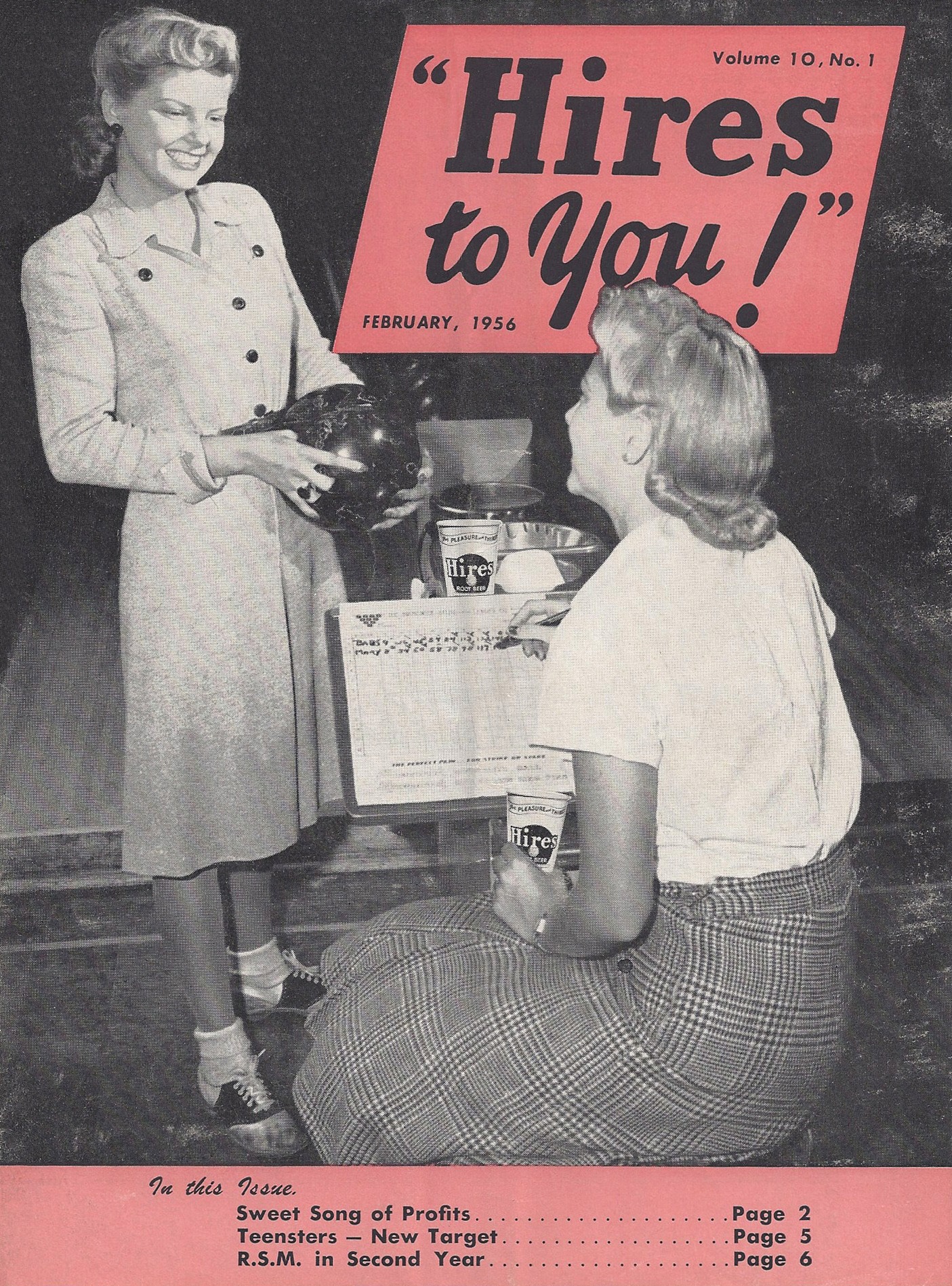
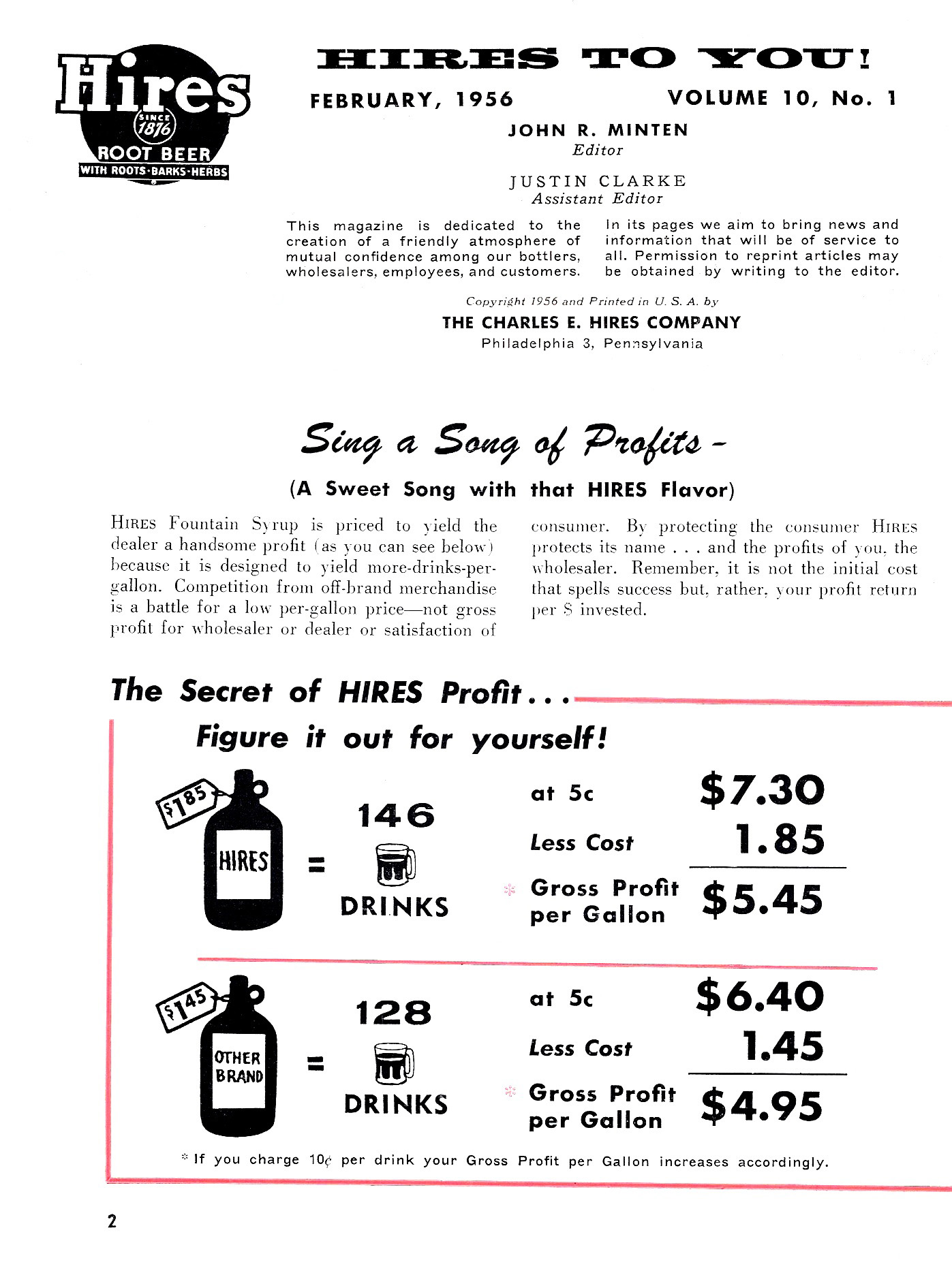









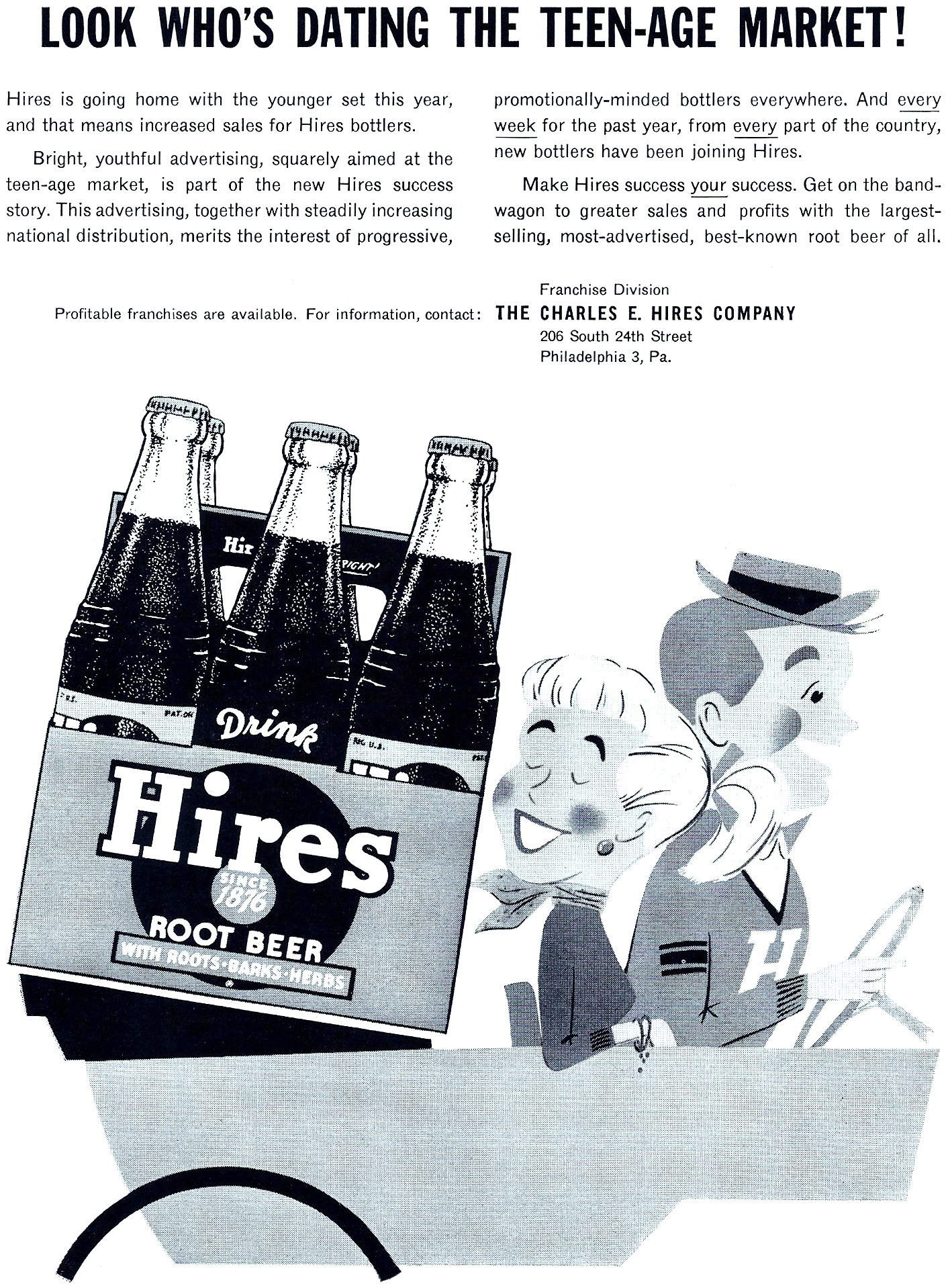

%20bottle%20-%20Hires%20to%20you%20-%20Detroit%20TV%20show.jpg)

%20Root%20Beer%20With%20Roots-Barks-Herbs%20-%20wooden%20case%20-%20end%20and%20side.jpg)
